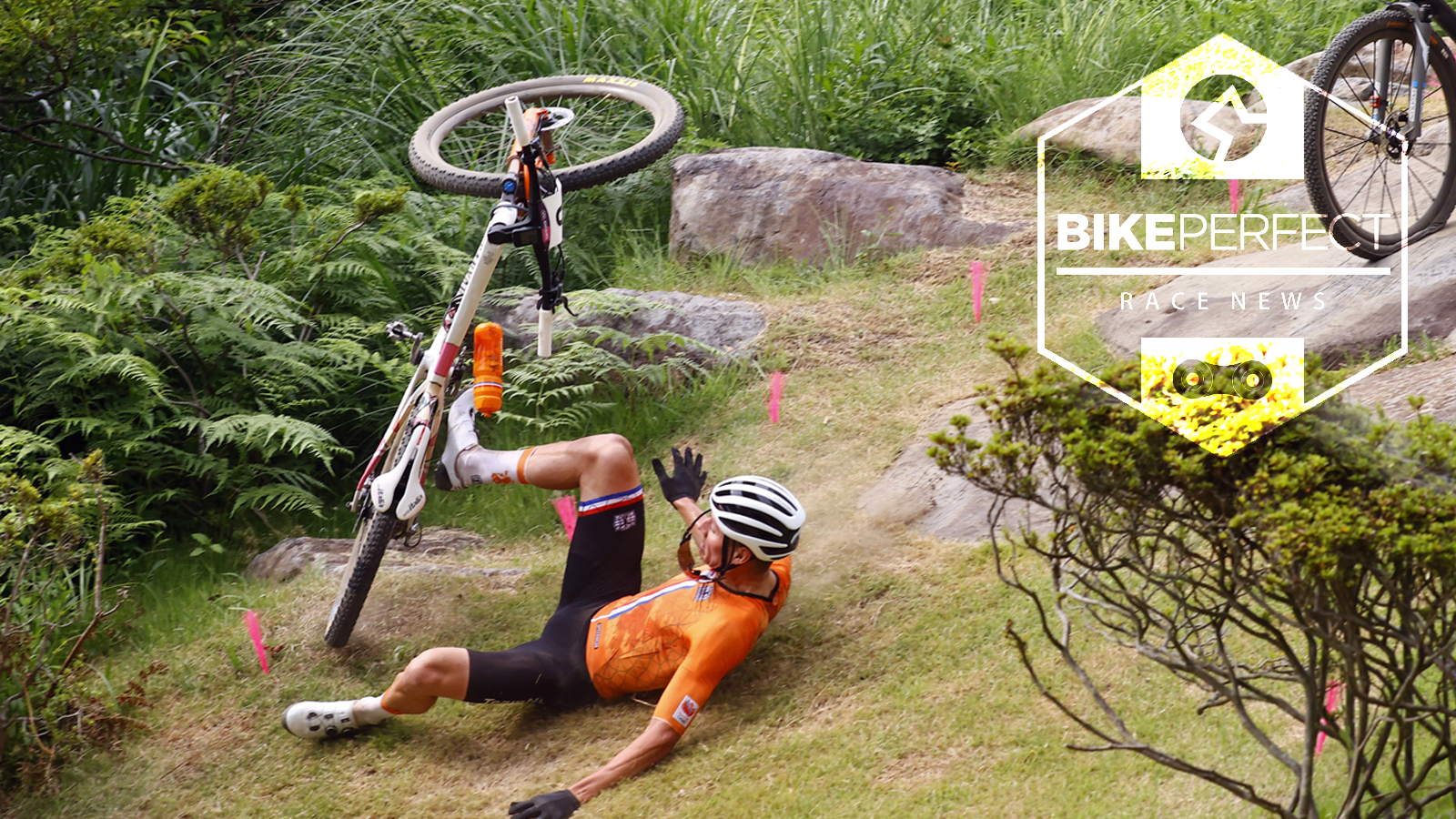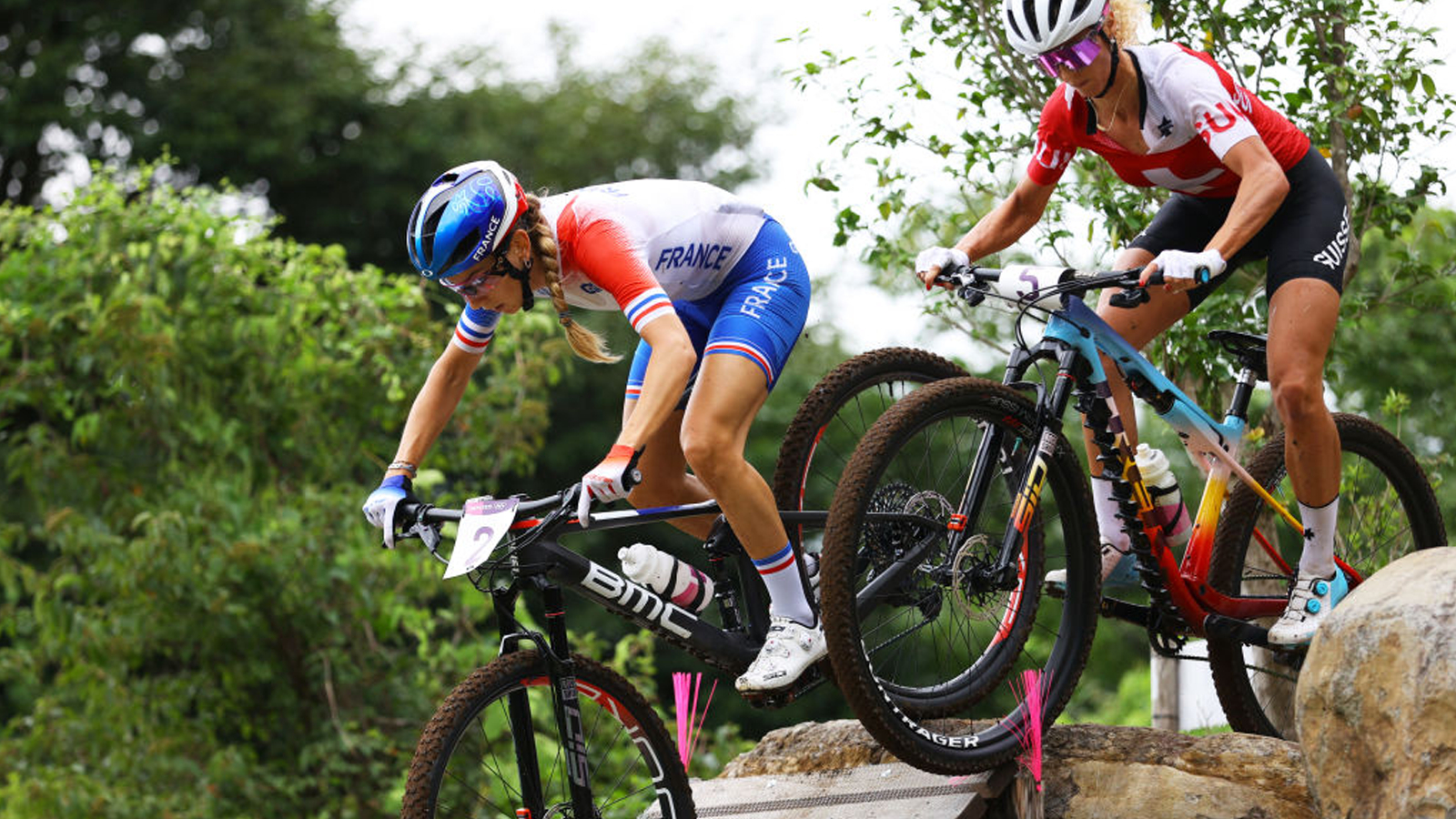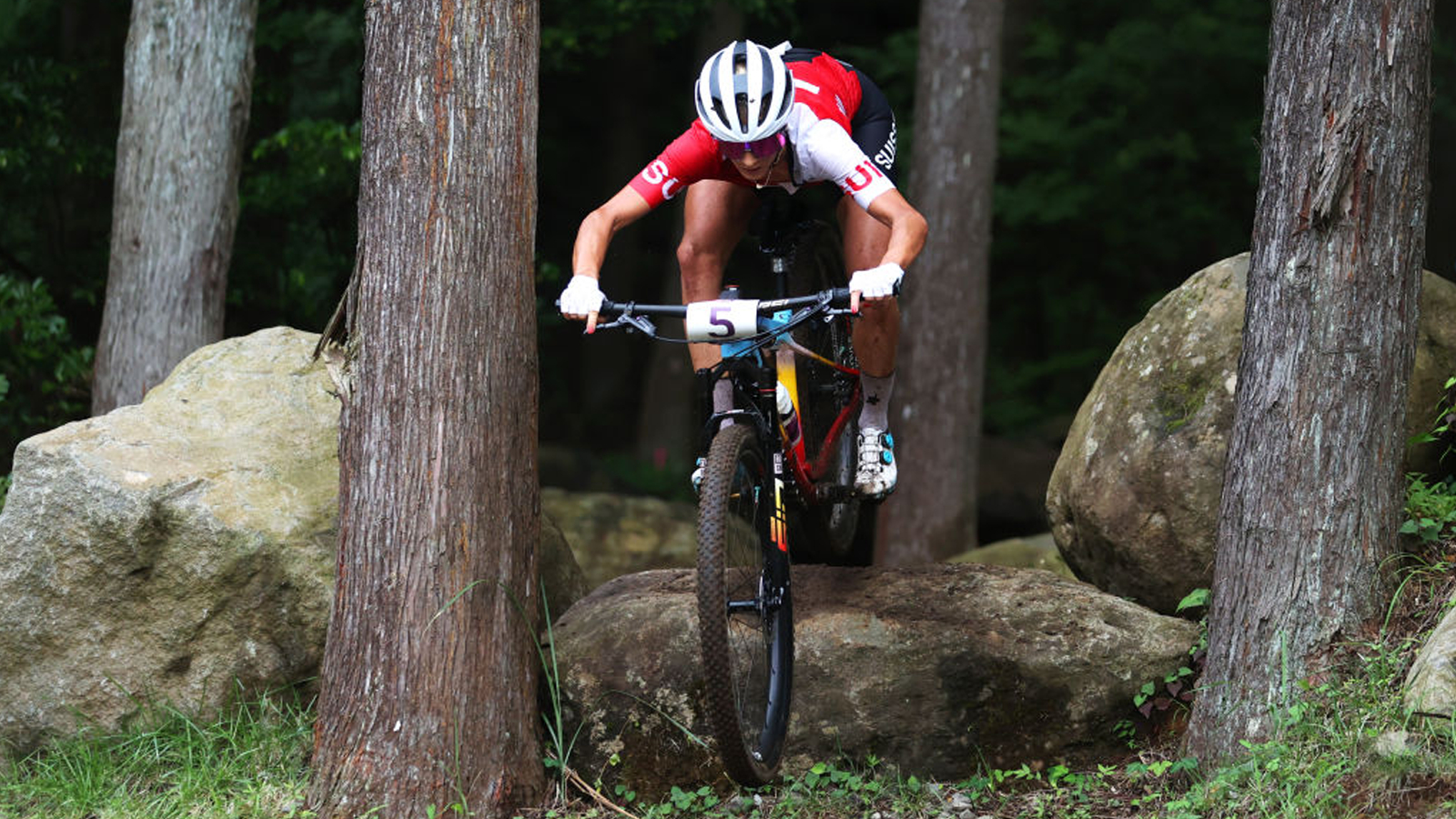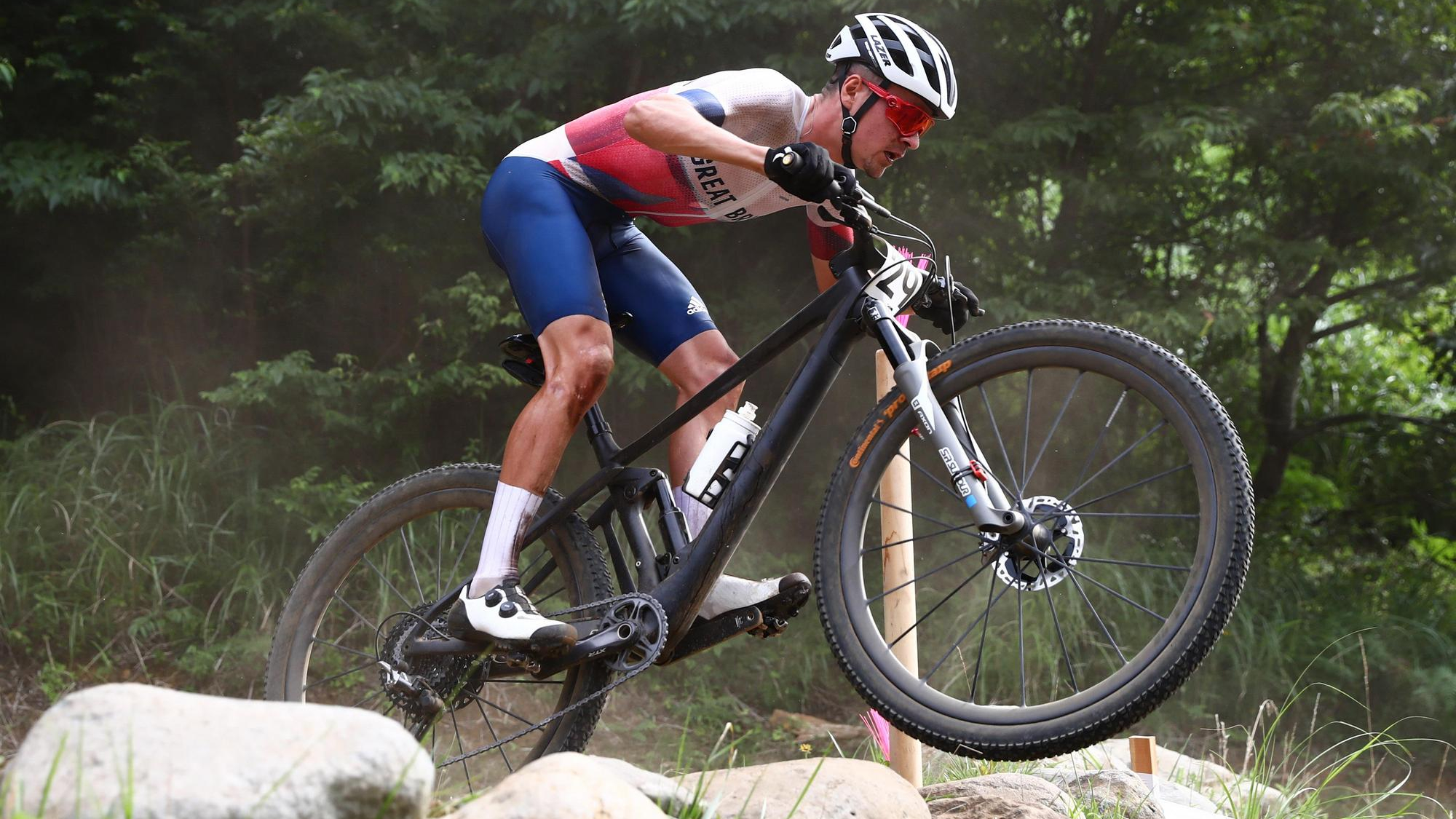Five conclusions from the Tokyo Olympic XCO MTB races
What we can learn from two fantastic races, with two dominant performances and some surprising mistakes

If you haven't seen the racing (what were you thinking?), what went down, and what can be learned from it?
The men’s race kicked off in a cloud of dust in brutally hot and dry conditions, with a much-anticipated showdown between dominant British 21-year-old upstart Tom Pidcock and Dutch superstar Mathieu van der Poel dominating pre-race punditry. It was the World Cup regulars making the pace as the Pidcock rapidly moved up from the fourth row to the top three on the start loop.
Then the race charged into the high-boulder send of the Sakura Drop section for the first time, and something seemingly inexplicable happened. While the leading riders floated the substantial drop-off in style, van der Poel nosedived into the deck, tomahawking into the bushes and nearly taking out Pidcock in the process. Although he restarted and fought on bravely, he eventually abandoned a minute down.
Meanwhile, at the front end the field, rapidly thinned over the relentlessly technical rock, root and dust bowl terrain, Swiss duo Mathias Flückiger and XC legend Nino Schurter were looking dominant until 33 minutes in. At that point, Pidcock snaked past on a narrow section of grassy singletrack and then put the hammer down repeatedly until only Flückiger could keep him in sight.
From there it was a textbook demonstration of utterly efficient and almost contemptuously relaxed, drop-steezing race craft until Tom rolled over the finish line with the Union Jack flag aloft 20 seconds ahead of a clearly battling Flückiger.

A frantic start for the women’s race saw 19-year-old Hungarian Katia Vas charge from last on the course to the front, and then go down on one of the first corners after overnight rain turned the course into a skating rink and saw some of the most technical rock A-lines closed off for safety.
Then it was a local sports category race-style elbow fight between French riders Pauline Ferrand-Prévot and Loana Lecomte, Swiss racer Jolanda Neff and UK’s Evie Richards. Neff stayed cool in the 82-degree heat as the French riders slipped on sniper roots to take the lead, and then somehow survived a total nose dive off the ramped Sakura drop — the same feature that took out van der Poel — after being stalled by Prévot on the entry.
Neff attacked through a pump section to launch the next rock upslope where a pulled pedal saw Prévot fall into the catch netting as her bike rolled back down the hill and that was all Neff needed. From there it was an absolute showcase of Swiss precision on a course the team had practiced on exhaustively since arriving in Japan.
Neff had previously won the trial event in 2019 too and was clearly loving the challenging features, sending her custom-painted 60mm-travel Trek Supercaliber and making full use of her RockShox Reverb AXS dropper post. The Swiss technical training focus saw Sina Frei and Linda Indergand flank Neff on the podium for an unprecedented Gold, Silver and Bronze medal sweep.
- Final results from the Men's XCO MTB at the Tokyo Olympics
- Tokyo Olympic Games: What we know about the mountain bike course
Five key lessons from the Olympic MTB races
1. Look before you leap
When it happened we couldn’t fathom how MTB, cyclo-cross and road-race legend (he left the Tour De France where he’d spend several days in the yellow jersey early to prep for Japan) Mathieu van der Poel nosedived the Sakura drop like a ‘Friday Fails’ newb. The explanation was actually relatively simple though. During training there had been a ramp down the drop and MVDP said he had missed the memo about it being removed for the race (although teammate and eventual top ten finisher Milan Vader said later that he had told him).
Lesson learned? There’s never been a clearer, higher profile — or more memed — example of always checking what you’re going to ride before you send it.

2. Skills pay the bills
With four medals out of six (and a 4th and 12th, too), the Swiss were undoubtedly the dominant nation of the Olympics and arguably have been for the last decade. As much as having a highly competitive squad will always elevate overall performance, the Swiss place a premium on skills training right from the start of a rider's career.
Schurter is a total shredder famed for infamously brutal ‘cross-training’ style workouts. Flückiger is an absolute animal with his Albstadt 2017 crash being one of the hardest on record. Neff has only just come back from damaging her spleen while riding her DH bike.
Tom Pidcock has also declared he wants to add a World Cup DH race and Red Bull Rampage appearance to his World Championship MTB and Cyclo-cross wins. This kind of technical confidence is getting more and more important as XC courses get increasingly technical too, but there’s still a weird acceptance from many racers that they’re crap downhill and don’t do anything about it.
Lesson learned? Even for XC, vertical skills are increasingly as important as your VO2 Max.
3. Sticks and stones may break your bones
Pushing those skills or just getting the training time in may expose you to more risk of injury. Tom Pidcock got taken out by a driver who broke his collarbone two months out from Tokyo. Jolanda Neff has just come back from a serious spleen injury when she broke her hand two months before Japan too. Clearly neither of them panicked, they just transferred to stationary trainers and, ahem, cracked on, still managing to hit peak form for Izu.
Lesson learned? Don’t give up even if you’re badly dented.

4. XC racing is the new Enduro
Okay, so skin suits and no peaks are still a vibe-killer for a lot of viewers, but bikes with increasing amounts of full-suspension travel, 2.4in tires, progressive geometry and dropper posts being rallied head to head over seriously technical courses by super-skilled riders, is an awesome spectacle.
Plus with just 4km of course to film, you can get way better TV coverage than you can with an Enduro spread over 60km of assorted mountains, often in the middle of nowhere. The same applies to spectating and competing too, as you can rock up on pretty much any kind of bike and have a go at some level without it being dangerous.
Lesson learned? XC is getting a lot more eXCiting but it’s still the most spectator-, TV- and ‘have a go’-friendly MTB sport.
5. Drop it like it’s hot.
We covered this a couple of weeks ago but we’re still surprised how many XC riders still don’t run dropper posts. VDP was the obvious high poster, but Anton Cooper and several others weren’t dropping saddles either.
Pidcock could be seen extending the minimal 80mm stroke of the integrated dropper post on his BMC Four Stroke however and Neff, Flückiger and Schurter were certainly on ‘party posts’ and clearly enjoying having more space to shake their skills on the steepest, techiest sections.
Lesson learned? A few 100g extra for a dropper post loses you less time than slow speed high-posting descents or a full over-the-bar-slam.

Guy Kesteven has been working on Bike Perfect since its launch in 2019. He started writing and testing for bike mags in 1996. Since then he’s written several million words about several thousand test bikes and a ridiculous amount of riding gear. He’s also penned a handful of bike-related books and he reviews MTBs over on YouTube.
Current rides: Cervelo ZFS-5, Specialized Chisel, custom Nicolai enduro tandem, Landescape/Swallow custom gravel tandem
Height: 180cm
Weight: 69kg
